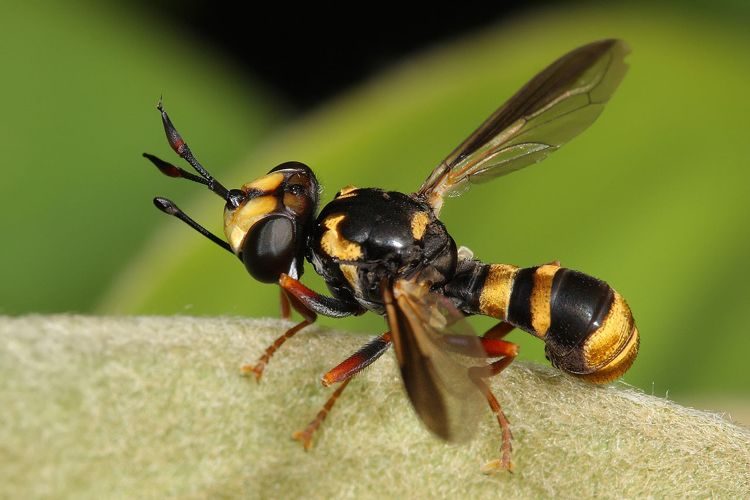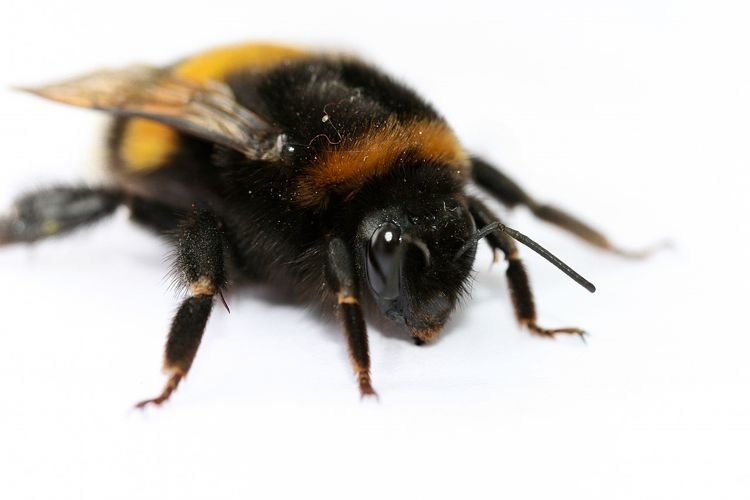As if habitat loss and pesticide exposure weren’t enough to deal with for bumble bees, they also face increasing pressure from a parasitic fly that attacks them midair, injects them with eggs with hatch larvae which proceed to eat the pollinators from the inside before finally forcing them to dig their own graves.
It sounds like something out of a body snatchers horror movie, but the conopid fly is very much a real-life threat for bumble bee colonies already under a lot of pressure from human activities. The conopid fly is classified as a parasitoid, a parasite that not only feeds on its host, but ends up killing it in a gruesome, terrifying way. We’ve featured creepy body snatchers in the past, some that turn their host into zombies, others that simply take control of their bodies but leave their brains intact, but the conopid fly is even worse. It literally eats bumble bees from the inside, before somehow forcing them to land on the ground and dig a whole to die in. The injected parasite grows inside the host and ultimately bursts out of it as a mature conopid fly that attacks other bumble bees and continues this nightmarish cycle.

Photo: Fir0002 (GDFL license)
Conopid flies have a very sneaky way of infecting its victims. Adult female flies will lie in wait in a patch of flowers that is likely to attract pollinators, and when a bumble bee gets close enough, it takes off and dive-bombs the bee in mid-air. Conopids are tiny compared to their victims, but the force of the impact is strong enough to send the bumble bee crashing to the ground. That’s the least of the pollinators problems though, as they are quick to recover their bearings and fly off, oblivious to the fact that they’ve been infected with a parasite that will kill them in a matter of days.
The conopid fly’s dive bomb is very carefully executed. As it hits the bumble bee, the parasitoid jams its ovipositor into the victim’s abdomen and inserts an egg into it. According to bumble bee expert Rosemary Malfi, “the ovipositor is like a can opener that opens the bee’s abdominal segments and shoots an egg inside”. It takes two days for the egg to hatch into a hungry conopid larva that starts to feed on the bumble bee’s hemolymph, its blood. As it grows, it starts consuming the host’s gut tissue as well, literally hollowing it out from the inside, while it’s still alive.
After about 10 days, something very strange happens. The infected bumble bee will land on the ground, and use its small legs to dig itself a hole in the ground. It then crawls into it and dies. It’s not clear how the parasite forces bumble bees to do this, but according to one theory it somehow tricks the victim to act like a queen bee getting ready to hibernate for the winter.

Photo: Marco Almbauer/Wikimedia Commons
But the cycle doesn’t end with the host’s death. In the cozy protection of the bumble bee’s buried body, the larva develops into a pupa and the following spring an adult conopid fly bursts out of the shallow grave, ready to stalk and infect other bumble bees.
Studies have found that conopid parasites not only eat and ultimately kill their hosts, but also radically affect their behaviour. For example, a Swiss study found that infected baumble bees also seem to change their foraging behaviour radically. Entomologists Regula Schmid-Hempel and Christine Muller of the Zoological Institute of the University of Basel studied such these infected insects and found that they tend to spend less time in the nest and more time foraging for food.
The researchers analysed the nests of 140 bees during the night, when no bees should be foraging, and found that only 5.7 per cent of bumble bees had been infected by conopid flies. By comparison, as many as 70 per cent of bumble bees outside the nests were parasitised. These led them to conclude that infected bees probably don’t return to the nest at all after being infected. There are two possible explanations for this. The first is physical stress – the bumble bee behaves strangely because it is being consumed from the inside. The second has to do with the conopid larva’s defense mechanism. While the bumble bee nest would offer it protection from predators, it also exposes it to fungi common in such nests. Scientists have yet to discover which theory is correct.
Conopid flies have always targeted bumble bees, it’s just how nature works. However, with human activity already decimating bumble bees worldwide, their parasitic behaviour has become a serious problem. Simply put, conopids have a bigger impact on bumble bee colonies than before, because the pollinators are now dealing with man-made threats as well.
Sources: Roadside Science, New Scientist, Atlas Obscura






